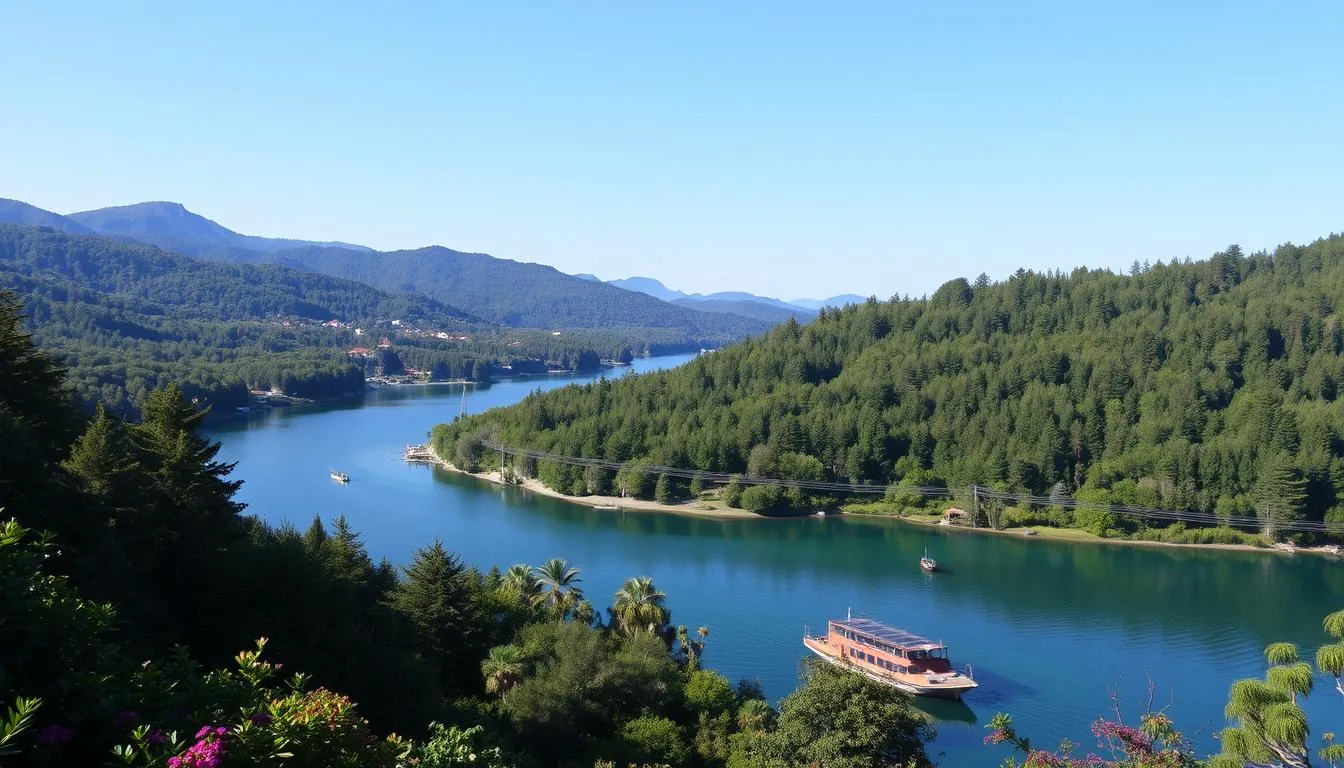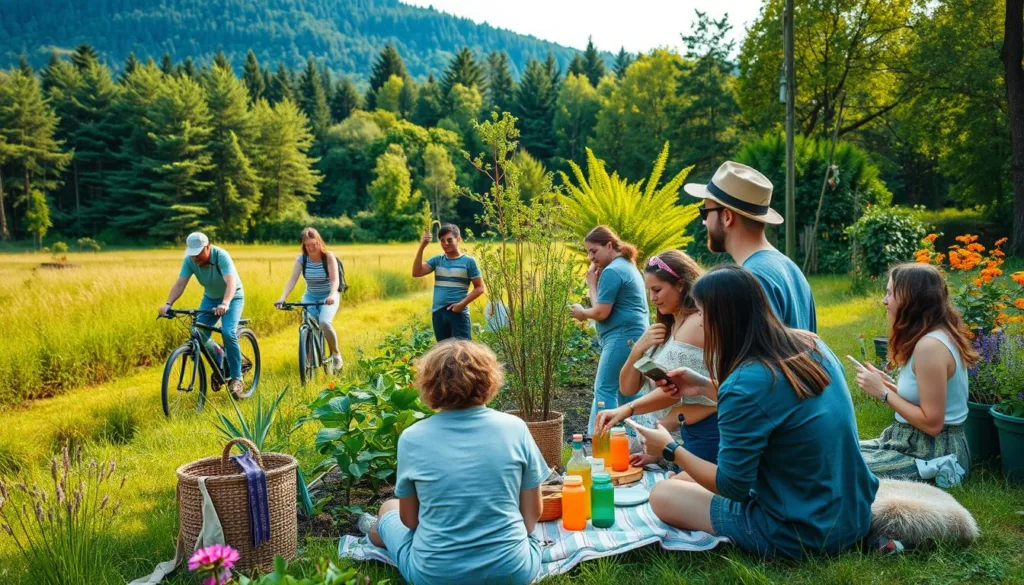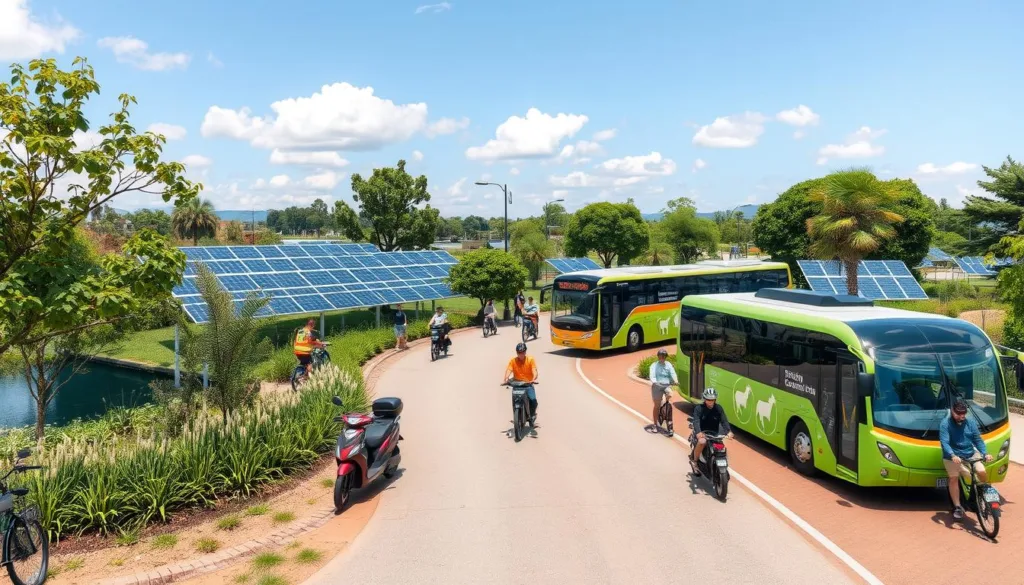In today’s world, caring for the environment is more important than ever. Sustainable tourism is becoming a big deal. It lets us travel in a way that’s good for the planet and helps local communities.
This article will share tips and places to visit for those who care about the environment. We’ll explore how to travel responsibly and see the world’s wonders without harming them.
Key Takeaways
- Sustainable tourism focuses on saving the environment and helping communities.
- Traveling responsibly can lessen the harm of too many tourists on places and people.
- Traveling green lets us connect with and support local areas.
- Choosing green ways to get around, staying in eco-lodges, and seeing wildlife responsibly can cut down on pollution.
- There are many places around the world where you can travel in a way that’s good for the planet.
Understanding Sustainable Tourism: A Modern Traveler’s Guide
As travel lovers, we must make sure our trips help the world. Sustainable tourism leads to eco-friendly and community-focused travel. Let’s explore how to travel responsibly, the downsides of too many tourists, and the perks of green choices.
Defining Responsible Travel Practices
Responsible travel is more than just seeing sights. It’s about thinking about the environment, people, and economy. We support local businesses, reduce waste, and respect cultures. This way, we help places stay sustainable for the future.
The Impact of Mass Tourism on Local Communities
The tourism world brings jobs but also problems. Too many tourists can harm places. They can crowd out locals, use up resources, and change cultures. By choosing wisely, we can lessen these issues and help communities grow.
Benefits of Eco-Conscious Travel Choices
Choosing eco-friendly travel is good for the planet and makes trips better. It supports local shops, cuts down on pollution, and lets us truly connect with cultures. Making smart choices helps keep places beautiful and makes a difference.
“Sustainable tourism is not just about being eco-friendly; it’s about respecting the delicate balance between travelers, local communities, and the environment.” – Jane Doe, Sustainable Travel Expert
Essential Tips for Reducing Your Carbon Footprint While Traveling
As we travel, we must think about our impact on the environment. There are simple steps we can take to lessen our carbon footprint. Let’s look at some key tips for traveling in an eco-friendly way.
Choose Sustainable Transportation
Transportation is a big part of our carbon footprint. Choose options like trains, buses, or electric cars when you can. Try to avoid short flights and combine trips to cut down on flying. If you must fly, look into carbon offset programs to balance out your emissions.
Embrace Eco-Friendly Accommodations
When picking where to stay, look for places that care about the planet. Search for hotels or rentals with green certifications like LEED or Green Key. This ensures they’re working to reduce their environmental impact.
Minimize Waste and Conserve Resources
- Bring reusable water bottles and avoid single-use plastic.
- Sort and recycle your waste properly during your stay.
- Conserve energy by turning off lights and electronics when not in use.
- Opt for sustainable local cuisine and support ethical food establishments.
Offset Unavoidable Emissions
Even with our best efforts, some emissions are unavoidable. Join reputable carbon offset programs to balance out your footprint. This supports environmental projects.
By following these tips, we can all help reduce our carbon footprint. Every small action we take helps protect our planet for the future.
| Sustainable Travel Tips | Impact on Carbon Footprint |
|---|---|
| Choosing public transportation over flying | Significantly reduces emissions |
| Selecting eco-friendly accommodations | Minimizes energy and resource consumption |
| Reducing waste and conserving resources | Lowers overall environmental impact |
| Participating in carbon offset programs | Neutralizes unavoidable emissions |
“Sustainable travel is not about giving up the joy of exploration, but about finding ways to experience the world with a lighter footprint.”
Green Transportation Options for Eco-Conscious Travelers
Eco-conscious travelers want to reduce their environmental impact. The choice of transportation is key. Air travel is convenient but has a big carbon footprint. Now, more people are looking at greener options.
Train Travel vs. Air Travel Environmental Impact
Train travel is better for the planet than flying. Trains emit less carbon dioxide per passenger-mile. They also use renewable energy, making them even more eco-friendly for long trips.
Electric Vehicle Tourism Routes
Electric vehicles (EVs) are changing travel. Places are adding EV charging stations for scenic routes. This lets travelers see beautiful areas while being kind to the environment.
Bicycle Tourism Opportunities
- Bike-friendly cities: Places with good cycling paths and safe parking are attracting eco-travelers.
- Scenic cycling routes: Cycling lets you see the area up close, cuts down on carbon, and keeps you fit.
- Bicycle-sharing programs: Cities and tourist spots offer bike-sharing. It’s easy to use green transport this way.
Choosing green transport lets travelers enjoy their trips while helping the planet. It’s a win-win for both the environment and the traveler.
| Transportation Mode | Carbon Emissions per Passenger-Mile | Sustainability Advantages |
|---|---|---|
| Train | 14-170 grams CO2 per mile | Lower emissions, often powered by renewable energy |
| Electric Vehicle | 50-150 grams CO2 per mile | Zero direct emissions, growing charging infrastructure |
| Bicycle | 0 grams CO2 per mile | Emission-free, promotes physical activity and health |
| Air Travel | 230-650 grams CO2 per mile | Significant environmental impact, limited sustainable options |
“Sustainable transportation is not just about reducing emissions; it’s about creating a more livable, equitable, and resilient future for our communities.”
Sustainable Accommodation: Eco-Lodges and Green Hotels
More people want to travel in a way that’s good for the planet. Eco-lodges and green hotels are now top choices for those who care about the environment. These places focus on being kind to the earth, helping local communities, and doing things the right way.
Eco-lodges are especially loved for their work in saving nature and helping local people. They use clean energy, save water, and build with green materials. Visitors get to learn about local culture, join in on community projects, and enjoy meals made from local ingredients.
Green hotels are also a hit with those who care about the planet. They try to cut down on pollution by using less energy and managing waste better. Many offer ways to make your stay carbon-neutral, like planting trees.
| Feature | Eco-Lodges | Green Hotels |
|---|---|---|
| Energy Efficiency | Renewable energy sources (solar, wind, etc.) | Energy-efficient lighting, appliances, and HVAC systems |
| Water Conservation | Greywater recycling, low-flow fixtures | Water-saving measures, including low-flow showerheads and toilets |
| Waste Management | Composting, recycling programs, minimal single-use plastics | Recycling initiatives, reduction of single-use plastics, eco-friendly cleaning products |
| Community Engagement | Partnerships with local communities, cultural immersion experiences | Support for local businesses, employment opportunities for nearby residents |
It’s key to check if a place really cares about the environment before booking. Look for real proof, like certifications from groups like the Global Sustainable Tourism Council. This way, you know you’re choosing a place that truly values sustainability.
By picking eco-lodges and green hotels, you help protect the planet and support local areas. This choice helps make travel better for everyone and the earth.
Supporting Local Communities Through Mindful Tourism
We can make a difference when we travel responsibly. By choosing community-based tourism, we help local artisans and protect cultural heritage.
Community-Based Tourism Initiatives
Community-based tourism lets locals lead in tourism. It offers real experiences, letting visitors see the local way of life. This way, we learn about the culture and help the local economy grow.
Local Artisan Markets and Fair Trade
Local markets are great for finding unique items and supporting artisans. Fair trade ensures artisans get a fair price for their work. This helps them keep their traditions alive.
| Fair Trade Principles | Benefits to Local Artisans |
|---|---|
| Transparent and accountable partnerships | Consistent income and financial stability |
| Fair wages and safe working conditions | Ability to invest in their communities |
| Environmental sustainability | Preservation of traditional crafts and knowledge |
Cultural Preservation Through Tourism
Tourism can help keep local cultures alive. By enjoying authentic experiences and respecting traditions, we protect them for the future. This boosts the community’s pride and sense of belonging.
“Responsible tourism is not just about minimizing our environmental impact; it’s about cultivating meaningful connections with the people and places we visit.”
By choosing community-based tourism, we support local artisans and respect cultural heritage. This makes our travels have a lasting, positive effect on the places we visit.
Top Eco-Friendly Destinations Around the World
More and more travelers want to travel in a way that’s good for the planet. They look for places that are kind to the environment. These spots let people see the world while helping to keep it green.
Places like Costa Rica are leading the way. It’s a country in Central America known for its love of nature. Costa Rica aims to be carbon-neutral by 2021. Visitors can stay in eco-lodges, explore parks, and help local communities.
Scandinavia is another great example. Countries like Norway, Sweden, and Denmark are big on being green. They have lots of places that are good for the environment, like electric car-friendly cities and towns powered by renewable energy.
| Eco-Friendly Destination | Sustainable Features |
|---|---|
| Kyoto, Japan | Ancient temples, sustainable public transportation, and a focus on preserving traditional culture |
| Bhutan | Carbon-negative country, ecotourism initiatives, and commitment to environmental conservation |
| Monteverde, Costa Rica | Cloud forests, eco-lodges, and community-based sustainable tourism projects |
These places are just a few examples of where you can travel and help the planet. By choosing to travel in a way that’s good for the environment, we can all help protect our world for the future.
Minimizing Waste While Traveling: Practical Solutions
As eco-conscious travelers, we focus on reducing waste on our adventures. We can pack smart and choose sustainable food. These steps help us travel without harming the environment. Let’s explore some practical tips for a zero-waste travel experience.
Zero-Waste Travel Essentials
Start by getting reusable items to replace single-use plastics. Here are some key zero-waste travel items:
- Reusable water bottle
- Bamboo cutlery set
- Cloth shopping bags
- Silicone storage bags
- Reusable straws
Plastic-Free Packing Tips
Packing without plastic is easy. Follow these tips:
- Use solid toiletries like shampoo bars and deodorant sticks.
- Carry refillable containers for liquids and creams.
- Wear clothes and accessories made from natural materials.
Responsible Food Consumption on the Road
Eating sustainably on the go is fun. Look for local markets and street food. Choose seasonal, organic, and plant-based foods. Use your own containers for takeout and leftovers to avoid plastic.
By using these tips, you can travel with less waste. This helps reduce your carbon footprint and supports sustainable tourism. With a bit of planning, your trips can be both fun and eco-friendly.
Wildlife Tourism: Ethical Animal Encounters
As eco-conscious travelers, it’s important to think responsibly about wildlife tourism. Watching animals in their natural homes can be thrilling. But, we must make sure these experiences are kind and help protect wildlife.
Supporting good wildlife sanctuaries and conservation projects is key. These places care for animals and let visitors see and learn about different species safely and with respect.
Identifying Ethical Wildlife Encounters
When planning wildlife activities, look for these signs to ensure you’re being responsible:
- Sanctuaries or reserves where animals can move freely in their natural habitats.
- Places that teach visitors about wildlife conservation and how to travel responsibly.
- Projects that put animal welfare first, not making money or entertainment.
- Chances to see animals from a distance, without touching or handling them.
Avoiding Exploitative Animal Tourism
Some wildlife tourism focuses on making money, not caring for animals. Be careful of activities that involve touching or riding wild animals. These can hurt the animals and mess with their natural ways of acting.
| Ethical Wildlife Tourism | Exploitative Animal Tourism |
|---|---|
| Watching animals in their natural homes | Touching or riding wild animals |
| Helping conservation and staying in eco-lodges | Going to places with animal shows or rides |
| Learning about species and their homes | Doing things that mess with animals’ natural ways |
By choosing ethical wildlife tourism, you help wildlife conservation and make sure animals are treated well.
Eco-Friendly Travel: Sustainable Tourism Tips and Destinations
As eco-conscious travelers, we must reduce our environmental impact. We’ll explore how to do this while exploring the world. This includes best practices for environmental conservation, responsible photography, and supporting local projects.
Best Practices for Environmental Conservation
Traveling requires adopting sustainable habits to protect the natural world. Some key strategies include:
- Reducing waste by using reusable water bottles and avoiding single-use plastics.
- Respecting wildlife habitats by staying on designated trails and not feeding animals.
- Conserving energy and water in accommodations and transportation.
- Supporting local sustainability initiatives and eco-friendly businesses.
Responsible Photography and Social Media
Social media has changed how we share our travels. Responsible travel photography includes:
- Getting permission before taking photos of people or cultural sites.
- Avoiding geotagging sensitive locations to protect them.
- Sharing content that promotes conservation and sustainable tourism.
Supporting Conservation Projects
Travelers can help by supporting local conservation projects. This includes volunteering at wildlife centers or joining beach cleanups. These actions contribute to environmental conservation during our travels.
“Responsible travel means leaving the places we visit in better condition than when we arrived.” – Jane Doe, Sustainable Travel Expert
Green Travel Technology and Apps
In today’s world, travelers are using green travel tools and eco-travel apps to help the planet. These new technologies change how we see travel, making it greener.
GreenPal is a great app for finding places to stay that are good for the environment. It shows you eco-lodges and green hotels. Another app, Carbon Footprint Tracker, lets you see how much carbon you’re using while traveling. It helps you make choices that are better for the planet.
- Apps like Trippin’ and Green Guide give you info on green transportation. They show where to find electric car charging spots and bike paths. This way, you can travel without harming the environment.
- The SustainableTravel app has a big list of sustainable tourism activities. It includes things like seeing wildlife in a responsible way and joining local tours. It helps you plan trips that are good for the planet and the people you meet.
As sustainable tourism technology gets better, traveling green is becoming easier. Using these green travel tools lets travelers do less harm to the planet. They can also help local communities and see the world in a better way.
“Technology has the power to transform the way we travel, making it more sustainable and responsible. These green travel apps are just the tip of the iceberg in the journey towards a greener future for tourism.”
Seasonal Travel: Choosing the Right Time for Minimal Impact
Traveling during the off-peak season is smart for those who care about the planet. You’ll find fewer people and lower prices. Plus, you’ll help local communities thrive by visiting when they’re not busy.
Off-Peak Travel Benefits
The off-season lets you dive deep into a place’s culture, away from the crowds. It’s better for the planet because there’s less travel. Plus, you help local businesses when they need it most.
Weather Considerations for Sustainable Travel
When planning your trip, think about the weather and natural events. Choose times that are good for the planet and the place you’re visiting. This way, you can see wildlife and enjoy the best weather without harming the environment.









